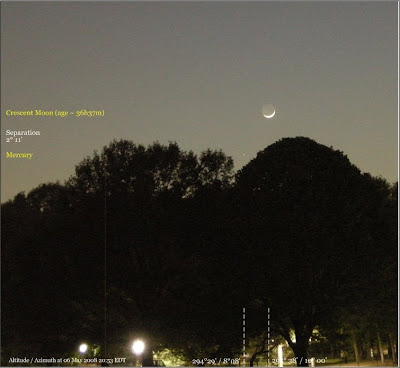Crescent Moon and Bright Nights
Session name: 20080506.1915
 This evening was much more fruitful. A teaspoon of the lunar disk, accompanied by ruddy-colored Mercury, settled into the trees on the western horizon after sunset. When the sky darkened during twilight and the mostly cloudy sky cleared to partly cloudy, a graceful, silvery curve appeared among the clouds.
This evening was much more fruitful. A teaspoon of the lunar disk, accompanied by ruddy-colored Mercury, settled into the trees on the western horizon after sunset. When the sky darkened during twilight and the mostly cloudy sky cleared to partly cloudy, a graceful, silvery curve appeared among the clouds.Young Sasha, around 6 years old, walked to the tripod and peered through binoculars for the first time at the Moon . I asked her what shape saw and she replied, tracing her finger along her chin, "a smile".
I couldn't make out any specific details of the crescent Moon. Mostly because I didn't look at any references. I looked for librated maria but didn't see anything. The cusps were beautiful as slender illuminated horns that held whispered light and dark at the extreme tips. I doubt it was M. Crisium but I did see a notch in that general area of the moon.
Maybe a dozen or more people would pass by. Ken the Pilot, stopped and chatted for a while, not having seen him for many months. When he arrived I remember how forbidding the western sky looked. Dark and opaque, low clouds wore rain skirts that fell away. Our persistence proved that Mother Nature is fickle. The clouds moved to the east with a steady pace leaving fairly clear skies after sunset.
 Looking manhattan-west from TotL image of Moon & Mercury.
Looking manhattan-west from TotL image of Moon & Mercury.Same image but unmarked of Mercury & Moon & Mercury setting.
Ken and I hosted others stopping and asking for what we were looking. I described how this crescent moon just passed alignment with the sun some 36 hours ago. (I mentioned the 12 hour crescent of yesterday but that may have fallen on deaf ears.) For those that arrived after the sunset, we observed the crescent, Mercury, and Saturn naked eye and through the 22x powered binoculars.
On crescent moons I like to remind the passersby of that we refer to near side and far side of the moon and that both sides receive sunlight. The crescent is just portion of the illuminated hemisphere where the majority of sunlight is falling on the far side. The crescent- shaped line we see separates night an day, the morning terminator line.
The near side of the Moon never really experiences dark nights. A person standing on the near side during New Moon is looking out into their night sky. (The far side is experiencing day.) And on this crescent evening where a lunar observer situated on the center of the Moon, Earth would be in waning gibbous phase, just past Full Earth.
This lunar observer would see a huge 2° disk reflecting much light back on to the Moon. We refer to this light as Earthshine and allows earth observers to see the Moon outlined and dimly illuminated on the background sky. For the lunar-based observer, one would mostly likely see their shadow from this Earthshine. Over time the Earth's phase wanes to New Earth but the lunar morning terminator advances. When the phase is New Earth for the lunar-based observer, it is Full Moon for the Earth-based observer.
This brief session provided more interaction than I expected. A birder and a photographer couple stopped and remarked of the sunset's beauty. At that time, I had just snapped some photos of a fan-shaped light - crepuscular rays - from the direction of the Sun. A man in a wheel chair described the sky in Argentina where he recently broke his foot. Later, the Columbia U. neuroscience student would ask after seeing Saturn & Titan if I return often to this spot. And others asked for looks and expressed delight and fascination with our solar system neighbors. Easily missed, otherwise unnoticed, but that wasn't going to happen from the Top of the Lawn.
Labels: binoculars, crescent, mercury, moon, Saturn
<< Home